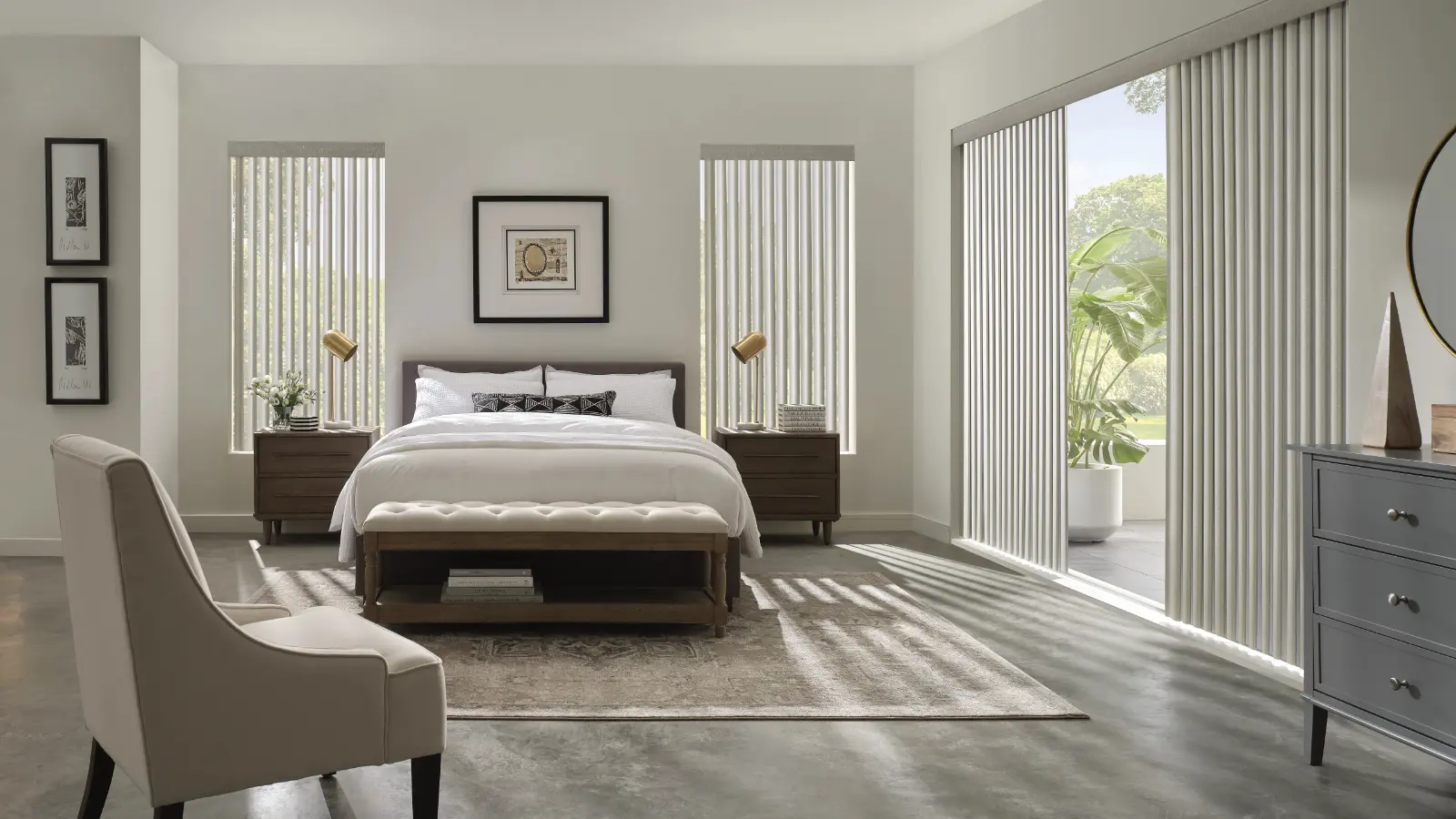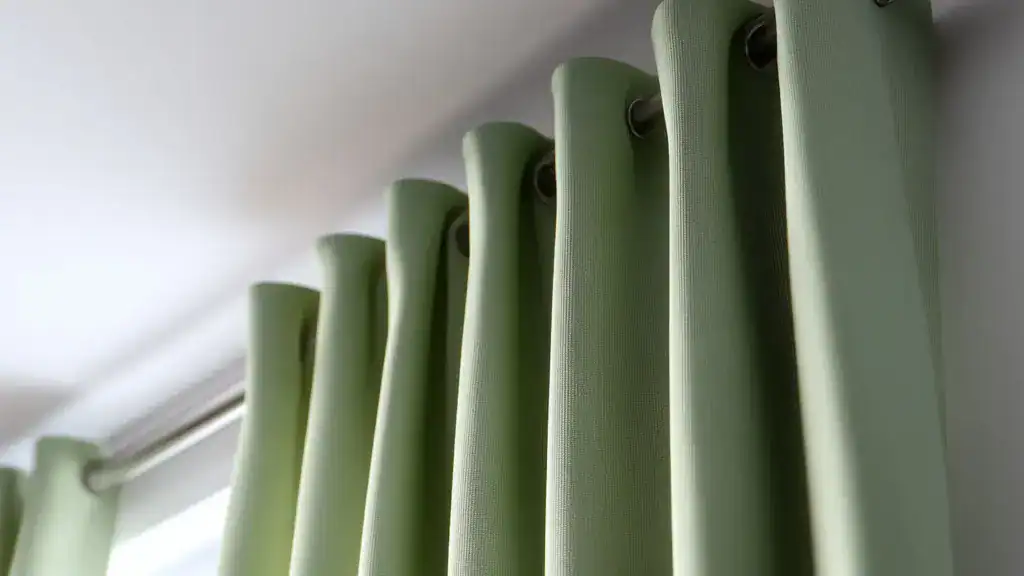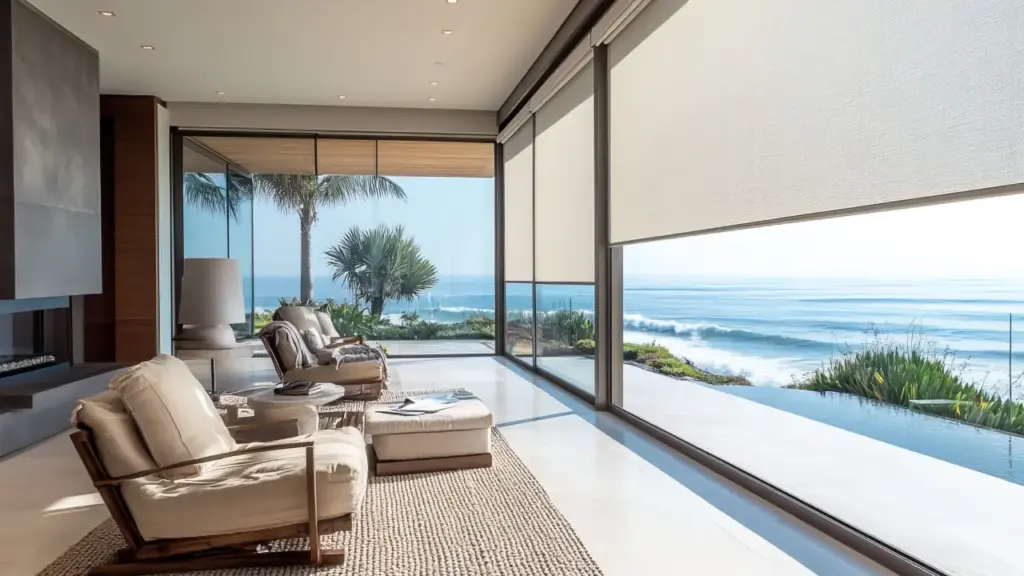Vertical Vs. Horizontal Blinds: Which Is a Better Fit for Your Home?

Unraveling the Blind Dilemma
Choosing window treatments can feel like a dizzying maze of options. Blinds or shades? Curtains or drapes? Solid color or patterned? Motorized or manual?
Even within the blinds family, there’s room for debate. Wide slats or narrow? What material? And then there’s the biggest bone of contention — do you go vertical or horizontal?
But each type of blind has pros and cons, and the size and location of the window you cover will have much to do with your ultimate choice. It’s not just a matter of budget and taste. In some situations, vertical blinds work better. In others, horizontal blinds get the nod.
Vertical Blinds: The Pros & Cons
Pros
- Perfect for sliding glass doors: Vertical blinds are ideal for expansive windows and sliding doors. Their vertical orientation makes them easy to operate and ensures complete window coverage.
- Easy cleaning and maintenance: Unlike horizontal blinds, the slats of vertical blinds don’t gather as much dust because of their standing position. This means less routine cleaning for you. Plus, if a slat gets damaged, you can replace it individually, saving you the cost of a whole new set of blinds.
- Excellent light control and privacy: One key advantage of vertical blinds is their superior control over light entering a room. You can easily adjust the slats to let in as much or as little light as possible. This versatility also enables you to change the privacy level in a snap. Close the slats for maximum privacy, or open them up to let the world in.
- Ideal for contemporary aesthetics: Vertical blinds have a no-frills, minimalist design that integrates well into modern home decor. Their clean lines can enhance the overall look of your space, making them a good choice for homeowners with a taste for contemporary design.
Cons
- Prone to tangling if not handled carefully: Vertical blinds get snarled if pulled with too much force. This might necessitate frequent adjustments or repairs.
- Limited design options: Styles can be somewhat limited compared to horizontal blinds, which come in a wide range of materials, colors, styles, and finishes, allowing for greater customization. You may have more difficulty matching vertical blinds to your existing decor if you have a specific color scheme or aesthetic in mind.
- May produce more noise: When the air conditioning or heating system kicks in, or even when there’s a breeze from an open window, the slats of vertical blinds can sway and clash. This might be a point to consider if you value an ultra-quiet living space. It’s nitpicky, but hey, you wanted to know the cons.
Horizontal Blinds: Pros & Cons
Pros
- Versatile design and material options: Horizontal blinds offer an impressive range of design possibilities, being available in myriad colors, finishes, and materials. This allows for a high level of customization to match any decor style, from rustic to modern. Material choices include wood, faux wood, aluminum, or vinyl, each with a different feel and cost.
- Excellent for smaller windows and standard sizes: Their horizontal orientation and narrower slats make them an excellent choice for smaller and standard-size windows, where vertical blinds would be overwhelming or clunky.
- More precise light control and privacy: You can easily adjust the direction and amount of sunlight coming into your space by tilting the horizontal slats. When fully closed,horizontal blinds offer complete coverage, making it difficult for outsiders to peer into your home. You might want to install them in rooms that require more privacy, such as bedrooms and bathrooms.
- Complement classic decor: Horizontal blinds have a timeless appeal that adds warmth and character to a room. They’re particularly well-suited for traditional or rustic decor.
Cons
- More difficult to clean: The horizontal orientation of the slats means that they collect more dust and debris than vertical blinds. This makes cleaning and maintaining them a bit more challenging, especially for those with allergies or asthma.
- Not ideal for large windows and sliding doors: While horizontal blinds work well for standard-sized windows, they may be a poor choice for large windows or sliding glass doors. They can be heavy and awkward to operate, making it difficult to get an even closure across the entire window.
- May obstruct views when raised: When fully raised, horizontal blinds can obstruct the top of the window and limit your view. This may be a detriment if you want to maximize your view and natural light in a room.
- Harder to repair: Unlike vertical blinds, where individual slats can be replaced, damage to horizontal blinds often requires a complete replacement. This is because the slats are strung together, and if one is damaged, it can affect the function and appearance of the whole set of blinds. Repairing horizontal blinds can be a tricky and may necessitate professional help.
Vertical Vs. Horizontal Blinds: The Clash of Features
1. Light Control & Privacy: Which Takes the Crown?
Vertical blinds excel in controlling light and privacy for wide spaces. They tilt open or close, offering flexibility in adjusting the amount of light and maintaining privacy.
Horizontal blinds are precision masters. Their tilting slats provide precise control over light angles, allowing for subtle adjustments throughout the day.
Verdict: It’s a tough call! Horizontal blinds take the lead if you crave precise adjustments and a classic look. But for those expansive windows and sliding doors, vertical blinds win the prize!
2. Design & Style: Which Flaunts the Flair?
Vertical blinds have a sleek, modern appearance that suits contemporary settings. While their design options are somewhat limited, they elegantly complement larger windows and modern interiors.
Horizontal blinds are all about versatility. With various materials, colors, and slat sizes, they blend effortlessly into traditional, rustic, or eclectic design themes.
Verdict: It all boils down to your home’s vibe! For a modern, expansive feel, you might prefer vertical blinds. But horizontal blinds are the clear choice if you seek versatility and a snug fit within smaller windows.
Making Your Choice: The Final Verdict
Consider window size, decor style, and functionality to pick the perfect contender for your space. There’s no one-size-fits-all answer here!
If you live in metro Los Angeles, we invite you to visit our Aero Shade showroom to view and test working models of the many window treatments we carry and customize, including blinds. Our experts can take you through the nitty-gritty of each covering and help you make an informed decision well within your budget.
Let us help transform your living space into a comfortable, stylish haven! We offer free in-home, no-obligation estimates. Call us at 323-457-2835 to get started.
FAQs: More about Blinds
Q: Can vertical blinds work for smaller windows?
Vertical blinds might overpower small windows. Horizontal blinds may be a better choice for smaller or even standard-sized windows.
Q: Are horizontal blinds suitable for sliding doors?
No, their slats can get in the way of the door’s functionality. Vertical blinds offer smooth operation for sliding doors.
Q: Can horizontal blinds be motorized?
Many horizontal blinds can be motorized for convenience, allowing you to adjust light levels with the touch of a button.
Q: Are vertical blinds more expensive than horizontal blinds?
The cost can vary greatly depending on the materials used and the size of the blinds. However, on average, vertical blinds are slightly more expensive than horizontal blinds.
Q: Can vertical blinds be shortened?
Vertical blinds can be shortened to fit your window perfectly. It’s a relatively straightforward process, and numerous online guides are available to walk you through it.
Q: Do horizontal blinds provide better insulation?
Yes, horizontal blinds often provide better insulation as they can create a tighter seal when closed, benefiting energy efficiency.
Q: Are horizontal blinds better for keeping out light?
This largely depends on the material and color of the blinds. However, when fully closed, horizontal blinds generally provide a better blackout effect than vertical blinds.
Q: Are vertical blinds outdated?
Not at all! While their popularity may have fluctuated over the years, vertical blinds remain stylish and functional, particularly for oversized windows and sliding doors.
Q: Can horizontal blinds be installed on French doors?
Yes, horizontal blinds can be installed on French doors. But it’s essential to ensure the blinds won’t interfere with the door’s functionality.
Q: Do vertical blinds require more maintenance?
Vertical blinds tend to collect less dust than horizontal blinds, so they may require slightly less regular cleaning. However, individual slats may need to be replaced if damaged.
Q: Can horizontal blinds be painted?
Wooden or metal horizontal blinds can be painted to match your decor. However, this should be done carefully to ensure a smooth finish and proper operation.


